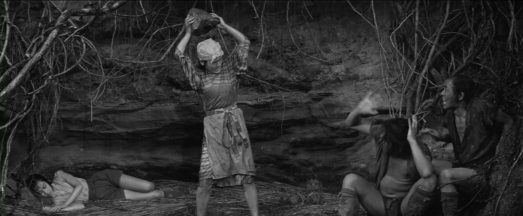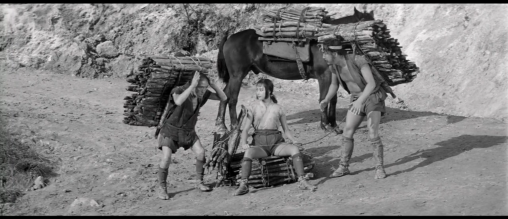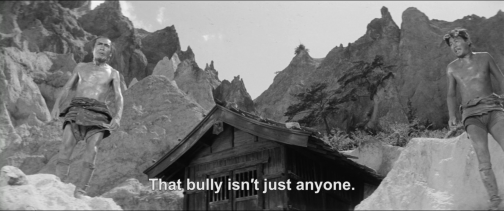
The Hidden Fortress (1958) is the most straightforward action adventure film Akira Kurosawa ever made. It was his most financially successful movie in Japan. It’s his first in widescreen. Its legacy though, is slightly misleading. The Hidden Fortress is usually referred to as the inspiration for Star Wars. While George Lucas freely admits to taking characters, it is not a point-to-point remake. Nor should its value be defined by it’s more famous descendent. It is an extremely enjoyable movie on its own. It had to be. Kurosawa had just made two back-to-back financial failures and he needed a hit. The failure of these films is usually attributed to how dark they were. So The Hidden Fortress is the light alterative. It has a simple story, broad comedy, sword fights, huge vistas, a feisty princess, fire festivals and hidden gold. It’s fun without feeling empty. It’s a template and tone American blockbusters have been trying to copy for half a century.
Warning– this post contains spoilers. To find out if I recommend the film or not, skip to Final Verdict.

First it’s best to list what Star Wars did take from The Hidden Fortress. The two peasants who open and close the film and are the audience’s point of view characters, were transformed into the droids R2-D2 and C3PO. The thrust of both narratives is about getting the princess out of hostile territory. Both employ wipes as transitions. They share a general tone and have similar music. Lucas offered Toshiro Mifune a role in the film, but he turned it down. And that’s it. Some might draw parallels between Mifune’s general and Han Solo, but that’s a reach. There is no “chosen one” story, or a mystical force or a Darth Vader character.

So what is this movie? It’s the story of a defeated royal clan trying to smuggle their heir and fortune into more hospitable lands, as seen through the eyes of two non-understanding peasants. There are high stakes, a clear goal, a number of formidable adversaries, and not much subtext. It’s a story that works, but plot is not the appeal of this movie. It’s the vivid characters, the beautiful visuals, and the general, for lack of a more accurate word, fun tone.

Even though their effect on the plot becomes less important as the movie progresses, the two peasants, Minoru Chiaki and Kamatari Fujiwara, are the heart of the film. They open the movie wandering from one absurd war to another. They are visually different, tall and pudgy vs. short and stringy, but outside of that they are the same character. They are fuelled by greed and incompetence. They will never pass up a chance at more gold, but they always go about it the worse way possible. They have one good idea in the entire movie. They figure out how best to leave the country and return home. The idea ends up saving their lives, when Mifune decides to use it.

It’s amazing they make it out of the movie alive. Not counting outside forces, it’s surprising they didn’t end up killing each other. Their relationship is a vicious cycle. They bicker about something, face great danger, come back swearing to remain friends and begin the cycle again. The performances manage to make it all endearing and funny. They are a point of view for the world and a humorous levity to this regal story. In the end of the movie they seem to stop fighting and be friends. The whole movie is just about them learning to be nice to each other. The Hidden Fortress might still be a good film without them, but it wouldn’t be nearly as distinctive. The regal story does have the princess with is a pretty good asset.

Disney now has a mental monopoly on cinematic princesses, but Princess Yuki (Misa Uehara) has little in common with them. She’s a competent warrior. She is able to easily keep the peasants’ sexual advances at bay with simply a stick (more on this later). She is neither delicate nor creepily sexualized, in fact compared to the men’s costumes she is modest. She wears shorts and a shirt. They look like sensible clothes for a day trip to the beach. She’s brass and loud, less interested with customs than with results. She is the unwilling leader, who’s more interested in the average person, which the film suggests makes her a better leader. This class system conversation is the closest the film has to a subtext. In Seven Samurai Kurosawa had peasants become Samurai. Here he has Samurai become peasants, which would suggest that the class system is arbitrary and that an individual’s worth is outside the system. I think that’s what the film is trying to say, but watching the film you get a different impression. The peasants and the royals are completely dissimilar. The royals are smart, competent and loyal. Mifune plays a Samurai who exudes authority and cleverness. He always wins through strength, skill, and smarts. He and the princess are the avatars for the ruling class. The villains of the movie are also part of the ruling class, but the only one of them we get to know is Susumu Fujita’s character who is redeemed with bravery.

The rest of the villains are a faceless horde. Who is the avatar for peasants? Chiaki and Fujiwara, the embodiment of greed and incompetence. Now we are given another peasant in Toshiko Higuchi who is smart, strong and loyal, but the two bumblers over shadow her. We don’t even find out her final fate. It’s a muddled message, which doesn’t necessarily make it a bad movie. The appeal of this movie is not the message, but the tone.

Tone can be hard to write about because they are feelings not ideas. The tone here is light, exciting, adventurous and fun. What’s odd about it is that the tone is somewhat at odds with the material. The movie opens with complaints about how they smell like corpses. Both of them just escaped the job of burying the dead.

How did they get here? In hopes of wealth they sold their farms, only to arrive too late and be mistaken for the losing side. While they are wandering the desert with only the filthy clothes on their back, a samurai is murdered in front of them. They separate only to both be captured and put into salve labor camps. How is this upbeat? Their performances are part of it. They don’t have internal lives; it’s all on the surface. As performers they are not looking for pity, but laughs. They are so lucky in avoiding certain death, when they miss a violent slave revolt by cowering in fear at the right place.

They are unlucky in achieving any other goal besides survival. They are useless, but untouchable. Fools stumbling through events they don’t understand. Their personalities keep their misfortunes at a distance for the audience. They are horrible, horrible people. They try to rape the princess multiple times.It’s hard to feel too sorry for them. But we don’t hate them because they are so incompetent at doing these terrible things. Their rape attempts are easily thwarted. Uehara nonchalantly bats them aside multiple times using only a reed. They are such fools they think they have a chance. A simple threat of a big rock stops them in their tracks. They become harmless.

All the scrapes, close calls, duels and cleverness really define the appeal of the movie. The set pieces don’t have primary subtextual value. They are about entertainment. How will they get through the checkpoint if they are searching baggage? Will Mifune kill the scout before he reaches camp? Will the peasants get them killed? I’m not going to reveal the answers because the joy is the reveal itself.

The music does much of the tonal heavy lifting. The score underlines much of the humor. When the peasants try to sneak away from Mifune with the gold, they try to convince the “mute girl” to stay. There is pantomime of horses to water and an attempt to sneak away. The slowness of their movements are contrasted by the fast paced soundtrack. With odd percussion and fast tempo it underlines the absurdity, creating a comic counterpoint. The music is reminiscent of the Star Wars cantina’s music.

This isn’t the music for the whole movie. Most of it is majestic. Soaring music plays over Uehara’s face super imposed over her clan’s flag. This is an adventure. The sights and sounds are big and slick. There is a danger to keep it exciting, but everyone in the audience knows everything is going to be fine.

The movie is one of Kurosawa’s most beautiful. He took full advantage of Widescreen (or Tohoscope). He filmed vistas (mountains, deserts, etc.), but he also used it in more unique storytelling ways. With extra space Kurosawa’s compositions became less crowded and more elegant. The visual information is more consciously directing the viewer from one side of the screen to another.

The wide space allows for him to play with the distance between the characters. Often times Chiaki and Fujiwara occupy far ends of the screen making the center this negative space.

Kurosawa uses depth of field, most notably in the introduction of Mifune. Chiaki and Fujiwara dominate the screen fighting over a small piece of gold. They separate and reveal Mifune above them at the top of a mountain pass. He is in the center of the frame. It’s one of Kurosawa’s most stylish films. The look matches the rest of the movie, brassy and simple, but it’s also apparent that you are in the hands of a master.

The Hidden Fortress is a very consciously a turn away from his recent work, but it draws from some of his earliest work. In a way The Hidden Fortress is a second draft of his film The Men Who Tread on the Tiger’s Tail. It’s an expansion of what was essentially a short (less than an hour) into a real honest-to-god movie. They have the same basic premise, royalty escaping hostile territory under supervision of an experienced general, all seen through the eyes of a lower class fool(s). In fact Susumu Fujita plays the same character in both movies, the opposition leader who lets them pass through. While The Men Who Tread on the Tiger’s Tail flaunted its artificial theatricality, The Hidden Fortress luxuriates in its real vistas. Some of Kurosawa’s films feel like revisionist of earlier movies (Quiet Duel and Red Beard, The Lower Depths and Dodes’ka-den). The second version is invariably the stronger film. This is partly because he had the good sense to only redo movies that didn’t quite work the first time. He never tried to redo Rashomon, Ikiru or Seven Samurai. Once something reached it’s potential, he moved on.

The Hidden Fortress introduced a new form and tone for Kurosawa. This was the first time he used the widescreen aspect ratio and he continued to use it after this point. The film’s tone he never quite recaptured. He never again made a film with such purely crowd pleasing goals. Though this entertainer side of Kurosawa became more prominent in his darker movies. Something like Yojimbo is in it’s own way as dark as Throne of Blood, but its postures and humor make it more digestible.

Final Verdict
The Hidden Fortress is Kurosawa’s most entertaining surface film. It’s his most humorous. When George Lucas and Steven Spielberg started reinventing American action cinema, this is what they were seeking to recreate. In a way it’s Kurosawa’s most accessible film. It is compulsively watchable. It’s not heavy and critically imposing as some of his “official” masterpieces can be. It’s a great gateway to Kurosawa. It’s fun.

The Hidden Fortress was released on DVD by Criterion and remains in print. It is also available to stream on Hulu with a subscription.
I can easily see the 2 central peasants in this film as being the ancestors of the funny robot duo in Star Wars. they are funny, vaudevillian and slapstick in how they relate physically many times rather than verbally.
The wide vistas where soldiers gallop like a paint brush, make you remember the old westerns which many of us growing up in the 40s, 50s, and 60s saw everything Saturday. It is not only the cinematography but the use of music. This movie allows the music to carry the plot along without actual action at times. The music heralds triumph, a battle which is on the horizon that we can’t see yet, love or a moment of recognizing humanity as an equalizer.
Most, definitely, Kurosawa helped lay down what the westerns became.
LikeLike